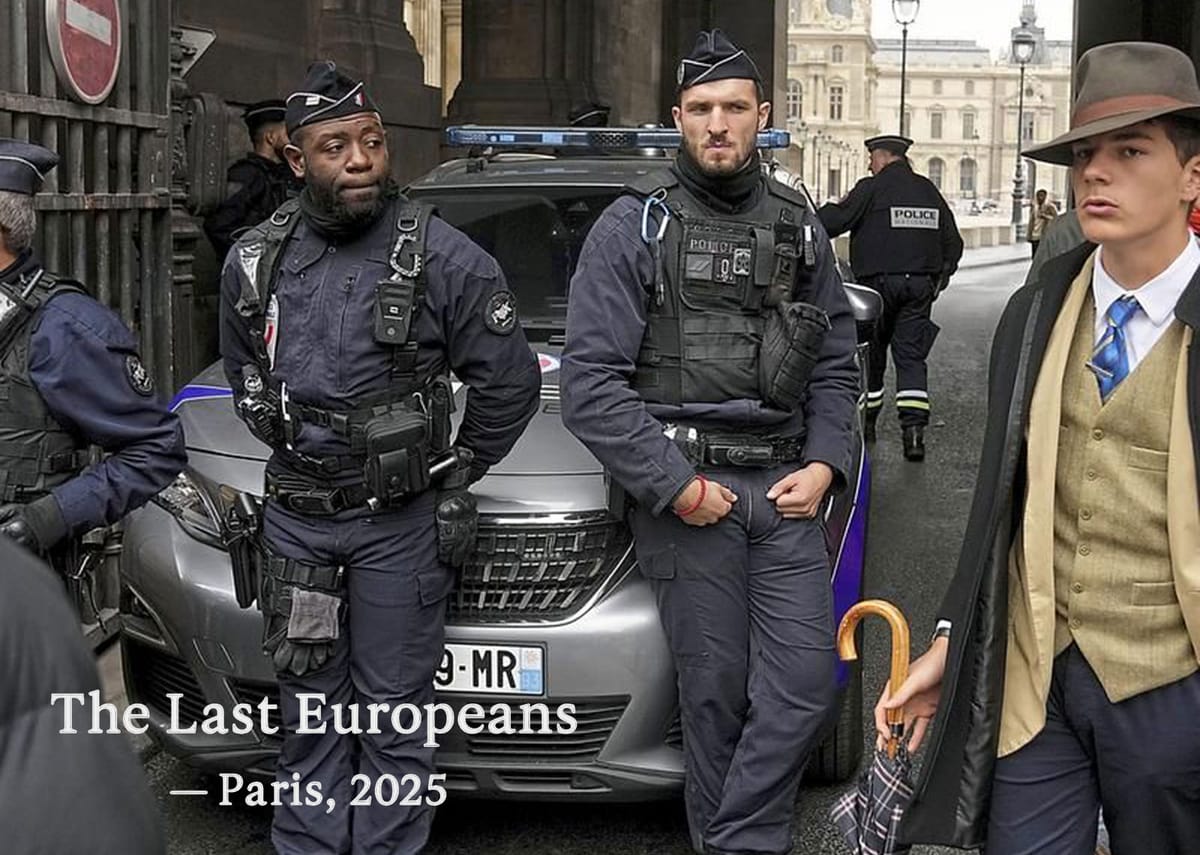The Louvre Detective and the Ache for Old Europe.
I stumbled on a photo that looked like the Europe I remember — French police, a man in a fedora, rain in Paris. I wanted to believe it was real. I traced it, tested it, and only at the end learned what I didn’t want to know.

Tinkering with Time, Tech, and Culture #22
The Photo That Hit Me
I stumbled on this photo yesterday — two French police officers, armored and serious, standing beside a Peugeot in the shadow of the Louvre.
And just to the right, a man in a three-piece suit and fedora, holding an umbrella like he’d stepped out of a 1930s film.
One of the most-shared posts came from social media commentator Ian Miles Cheong, viewed over 90,000 times. https://x.com/stillgray/status/1981083002613723397
He wrote: “The man in the fedora, who looks like he came out of a detective film noir from the 1940s, is an actual French police detective investigating the theft of the Crown Jewels at the Louvre. Pure aesthetic.”
It was everywhere — reshared, memed, celebrated. A frozen frame of something that shouldn’t exist anymore — the elegance, the confidence, the Europeanness of it all.
I wanted to believe it was real.
Why I Wanted to Believe
I’d been to Europe in the early ’90s, and again in 2017.
The difference was stark.
Europeans were less European — less cool, less sure, less of everything that made Europe Europe.
This photo looked like proof that something still lingered —
that style could survive pragmatism,
that grace could coexist with authority.
Maybe it wasn’t just nostalgia.
Maybe it was a reminder that culture is something you carry, even when the world stops noticing.
The Investigation
So I started digging.
I ran it through Error Level Analysis — the forensic tool that reveals where pixels have been tampered with.
No irregularities. No composite seams.
The light gradients were smooth, the compression uniform.
Reverse image results led me to a German article titled
“Frankreich jagt die Juwelenräuber”,
published October 20, 2025, by OVB Heimatzeitungen.
That felt right — real-world context, a news agency, a timestamp.
Everything about it seemed authentic.
Social-media users were already saying the man in the fedora was a detective investigating the Louvre jewel heist.
But according to Newsweek,
“The individual in the photo appears to be a very well-dressed and dapper passerby, but has no tangible connection to the investigation.”
— Is ‘French Detective’ in Fedora Solving Louvre Heist Real? What We Know, Oct 23 2025
For a while, I let myself believe it.
The Last Europeans
And then, because curiosity never leaves well enough alone, I ran one final test.
A modern one.
Hugging Face’s AI Image Detector.
Result: 100% AI-generated.
The bottom dropped out.
Not because it was fake — but because it had fooled my hope so completely.
Every pixel felt human.
Every detail — the raincoat, the fedora, the posture — had been authored by longing.
Maybe that’s what AI has learned to imitate best:
not perfection, but the ache for what we’ve lost.
So yes, it was fake.
But for one brief evening, it made me believe Europe still remembered itself.
And maybe that’s the saddest kind of truth there is.

Update (10/23/25 1:40PM PST):
It seems AP is the original source of the photo and it is real! But the person of interest is just a random passer buy.
I think the watermarking kept it out of the reverse image search.

